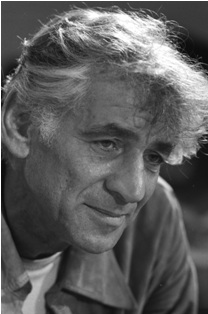
Rehearsing an Orchestra: Leonard Bernstein. Part IV. A Conducting Primer by Leonid Grin
Part IV.
Rehearsing an Orchestra.

OK, you’ve
met your orchestra and mastered the score.
Now to make music.
“Where is the conductor’s function most
important, in the rehearsal or in the concert,” asked Leonid Grin in his
lecture/master class for students of Neeme Järvi’s Summer Academy July 27 in Pärnu,
Estonia. And how do you distribute your time
and your energy?
Grin began
by asking a question: “How many times
have you seen or been through a concert that is just a repeat of the dress
rehearsal? This is certainly the wrong
thing. If you cannot make a step up from
dress rehearsal to concert level, you did something wrong. You overuse, you abuse the orchestra and
yourself. You always should have something left to move the next step up. Whether it’s three percent, five percent,
whatever it is, it should be reserved.”
Here Grin
applied one of his “nevers.”
“Never
rehearse the dress rehearsal in full power.
Most of us play through the dress rehearsal like it goes in concert
order, including myself. Sometimes it’s
needed, but not always. If you did a
good rehearsal cycle, then in a dress rehearsal, for example, if you play a
Mahler or Bruckner Symphony and you care for the lips of your wind and brass
players, you will take just this and this – or this is needed for string
ensemble. I like to tune the brass not
forte but piano. Don’t force wind or
brass in a dress rehearsal, otherwise you will have problems with the
concert. And do not overuse the winds
with rapid staccato or make the strings play lots of spiccato (with the bow
bounced on the strings). They will be
dead for the concert. You have to
respect the physical endurance of your musicians.”
The
rehearsal, Grin said, “is our signature, our handwriting. There you see the full personality, the full
knowledge and ability of a conductor. It’s
really an authentic signature.”
Conductors
all have different ways of rehearsing an orchestra, he said. “That’s fine, but whatever you do, you should
first have a very clear plan. What do
you want to achieve today and tomorrow and the next day until the last day of
rehearsal?”
You shouldn’t
adopt the attitude that if you don’t achieve what you plan today you can just
finish it tomorrow. Conversely, you can
make adjustments to your plan if you have to, he said. “But the plan should be very clear, step by
step to achieve the final result.”
As for style
of rehearsing, conductors vary widely, Grin said. “Some conductors talk more during rehearsals.
Some explain what they want. Some conductors like to just perform and
encourage.” Grin made his point vivid by
showing rehearsal videos of three great conductors, all of whom he worked with and
observed during his career: Leonard
Bernstein, Herbert von Karajan and Sergiu Celibidache.
They could
not have been more different.
First
Leonard Bernstein.
“He was a very happy person, very spontaneous, totally relaxed and open,” said Grin who worked with Bernstein for ten years after immigrating to the U.S. from the Soviet Union in 1981. “He would never hesitate to say to your face whatever he felt. He would say, ‘I hate you’ or ‘I love you’ or ‘You are an idiot.’"
Grin related the oft-told story of Bernstein’s
first encounter with the Vienna Philharmonic conducting a Mahler symphony: “Dies ist kein Mahler! Dies ist Vienna. Dies ist Vienna Philharmonic und Die Vienna
Philharmonic kann nicht Mahler spielen.”
(“This is not Mahler! This is Vienna. This is the Vienna Philharmonic and the
Vienna Philharmonic cannot play Mahler.”)
“They said, ‘We
cannot play Mahler? You are standing and
telling us we cannot play Mahler?’ The
next ten minutes they were looking at each other, but in 20 minutes it was a
totally different orchestra.”
Bernstein
would encourage you in enormous, imaginative ways, said Grin, who was selected by Bernstein to participate in his first Los Angeles Philharmonic Institute in 1982. When he conducted Stravinsky’s ‘Le Sacre du
printemps’ (“Rite of Spring”), he said to the New York Philharmonic French
horns, ‘No, that’s dinosaurs screaming. Can
you play like dinosaurs?’ And then you
know what? (Grin demonstrated the kind of roars the horn players made .)”
Another time,
to inspire a proper can-can in a piece of French music, he told the violin
section, which included several female players:
“Look at these ladies? Don’t they have beautiful legs?” said Grin. “In 20 seconds, the music was
exactly the way he wanted it. Bernstein’s
style of rehearsing was more like a mini-concert. He would rarely go into details unless it
would be really crucial. He would not go
for meticulous accomplishment in a rehearsal.
He was assured that the next day they would be encouraged by their
professional responsibility to seek a higher level of performance.”
Next:
Karajan and Celibidache